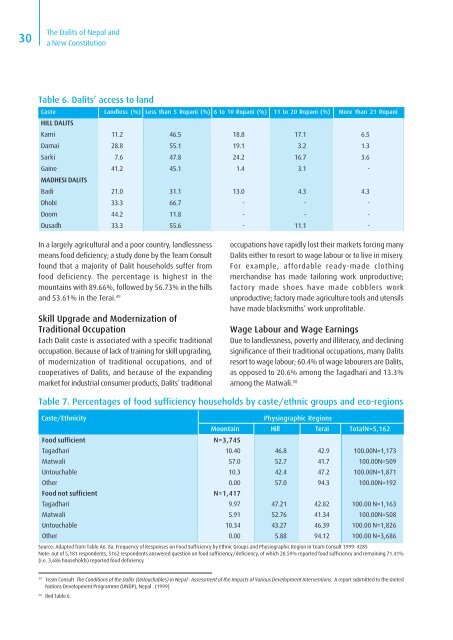The Dalits of Nepal and a New Constitution - ConstitutionNet
The Dalits of Nepal and a New Constitution - ConstitutionNet
The Dalits of Nepal and a New Constitution - ConstitutionNet
Create successful ePaper yourself
Turn your PDF publications into a flip-book with our unique Google optimized e-Paper software.
30<br />
<strong>The</strong> <strong>Dalits</strong> <strong>of</strong> <strong>Nepal</strong> <strong>and</strong><br />
a <strong>New</strong> <strong>Constitution</strong><br />
Table 6. <strong>Dalits</strong>’ access to l<strong>and</strong><br />
Caste L<strong>and</strong>less (%) Less than 5 Ropani (%) 6 to 10 Ropani (%) 11 to 20 Ropani (%) More than 21 Ropani<br />
HILL DALITS<br />
Kami 11.2 46.5 18.8 17.1 6.5<br />
Damai 28.8 55.1 19.1 3.2 1.3<br />
Sarki 7.6 47.8 24.2 16.7 3.6<br />
Gaine 41.2 45.1 1.4 3.1 -<br />
MADHESI DALITS<br />
Badi 21.0 31.1 13.0 4.3 4.3<br />
Dhobi 33.3 66.7 - - -<br />
Doom 44.2 11.8 - - -<br />
Dusadh 33.3 55.6 - 11.1 -<br />
In a largely agricultural <strong>and</strong> a poor country, l<strong>and</strong>lessness<br />
means food deficiency; a study done by the Team Consult<br />
found that a majority <strong>of</strong> Dalit households suffer from<br />
food deficiency. <strong>The</strong> percentage is highest in the<br />
mountains with 89.66%, followed by 56.73% in the hills<br />
<strong>and</strong> 53.61% in the Terai. 49<br />
Skill Upgrade <strong>and</strong> Modernization <strong>of</strong><br />
Traditional Occupation<br />
Each Dalit caste is associated with a specific traditional<br />
occupation. Because <strong>of</strong> lack <strong>of</strong> training for skill upgrading,<br />
<strong>of</strong> modernization <strong>of</strong> traditional occupations, <strong>and</strong> <strong>of</strong><br />
cooperatives <strong>of</strong> <strong>Dalits</strong>, <strong>and</strong> because <strong>of</strong> the exp<strong>and</strong>ing<br />
market for industrial consumer products, <strong>Dalits</strong>’ traditional<br />
occupations have rapidly lost their markets forcing many<br />
<strong>Dalits</strong> either to resort to wage labour or to live in misery.<br />
For example, affordable ready-made clothing<br />
merch<strong>and</strong>ise has made tailoring work unproductive;<br />
factory made shoes have made cobblers work<br />
unproductive; factory made agriculture tools <strong>and</strong> utensils<br />
have made blacksmiths’ work unpr<strong>of</strong>itable.<br />
Wage Labour <strong>and</strong> Wage Earnings<br />
Due to l<strong>and</strong>lessness, poverty <strong>and</strong> illiteracy, <strong>and</strong> declining<br />
significance <strong>of</strong> their traditional occupations, many <strong>Dalits</strong><br />
resort to wage labour; 60.4% <strong>of</strong> wage labourers are <strong>Dalits</strong>,<br />
as opposed to 20.6% among the Tagadhari <strong>and</strong> 13.3%<br />
among the Matwali. 50<br />
Table 7. Percentages <strong>of</strong> food sufficiency households by caste/ethnic groups <strong>and</strong> eco-regions<br />
Caste/Ethnicity<br />
Physiographic Regions<br />
Mountain Hill Terai TotalN=5,162<br />
Food sufficient<br />
N=3,745<br />
Tagadhari 10.40 46.8 42.9 100.00N=1,173<br />
Matwali 57.0 52.7 41.7 100.00N=509<br />
Untouchable 10.3 42.4 47.2 100.00N=1,871<br />
Other 0.00 57.0 94.3 100.00N=192<br />
Food not sufficient<br />
N=1,417<br />
Tagadhari 9.97 47.21 42.82 100.00 N=1,163<br />
Matwali 5.91 52.76 41.34 100.00N=508<br />
Untouchable 10.34 43.27 46.39 100.00 N=1,826<br />
Other 0.00 5.88 94.12 100.00 N=3,686<br />
Source: Adapted from Table A6. 8a. Frequency <strong>of</strong> Responses on Food Sufficiency by Ethnic Groups <strong>and</strong> Physiographic Region in Team Consult 1999: 4285<br />
Note: out <strong>of</strong> 5,181 respondents, 5162 respondents answered question on food sufficiency/deficiency, <strong>of</strong> which 28.59% reported food sufficiency <strong>and</strong> remaining 71.41%<br />
(i.e. 3,686 households) reported food deficiency.<br />
49<br />
Team Consult <strong>The</strong> Conditions <strong>of</strong> the <strong>Dalits</strong> (Untouchables) in <strong>Nepal</strong> : Assessment <strong>of</strong> the Impacts <strong>of</strong> Various Development Interventions. A report submitted to the United<br />
Nations Development Programme (UNDP), <strong>Nepal</strong> . (1999)<br />
50<br />
Ibid Table 6.








![g]k fnsf blntx? / gofF ;+l jwfg](https://img.yumpu.com/49483602/1/184x260/gk-fnsf-blntx-goff-l-jwfg.jpg?quality=85)



![+ljwfg;ef, /fHosf]k'g](https://img.yumpu.com/41604075/1/184x260/-ljwfgef-fhosfkg.jpg?quality=85)




